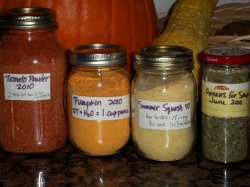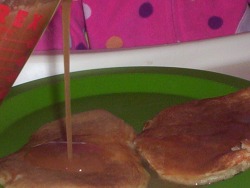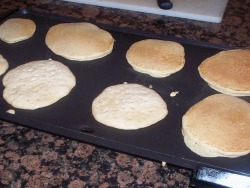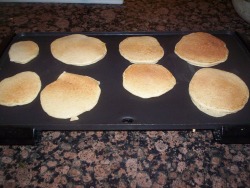

The idea behind this is that pureed squash can be added to soups and breads (as in Zucchini Bread), and it takes a LOT less storage space when it’s dried. There are at least two ways to get dried pureed squash:
(1) Puree it, pour it on food dehydrator sheets, dry, and roll up, and
(2) Slice the squash (1/4” wide is good), dry it like that, then run it through your blender when it’s crispy-dry. This vegetable powder takes up even less storage space than the leather, plus it reconstitutes faster. If you're doing this with pumpkin, steam it before slicing; it will dry quite a bit faster and not have that raw taste.
(3) Store it in something fairly airtight, in a dark area. Canning jars are great, especially if you seal them by using a new lid, the ring, and an oxygen packet. (see Dry Canning.)
Now, how do you use it in recipes? And how much do you use? Remember thinking in school that you’d NEVER use math in ‘real life’? Ha! It’s incredibly useful in the kitchen, especially when you start doing your own thing.
Measure and write down the quantity you start with, then measure and write down what you end up with. Write it on your storage container, trust me, you’ll forget otherwise. For instance, I started with 2 ½ lbs of yellow squash, which is 5 cups of puree. I ran it through the blender, poured it on my (SPRAYED) dehydrating sheets, and turned on the dehydrator until it was dry and curling up on the edges and thin spots. My sheets can fit two cups of puree each, which is one pound, so each roll of ‘leather’ is worth that much in a recipe. To use it in a recipe, tear it up in pieces and soak it in just under 2 cups of hot water, for probably 30 minutes or so. Then use it just like fresh puree, in whatever recipe you have. There are photos and more detailed information on the Zucchini Powder post.
For making the powdered squash: the latest batch, 5 cups of puree, became just 10 tablespoons after drying and powdering. That means to make one cup of puree, use 2 Tbsp. powder along with just under 1 cup hot water. Isn’t that amazing? Think of the space that saves! Five cups, which would have taken up freezer space, now stores in the space of about 2/3 of a cup. The pumpkin I dried requires 3 Tbsp. plus water to make a cup. This pumpkin powder bakes up beautifully in pies and breads.
When I make vegetable powder, it usually sticks to itself in a big lump after storing a little while. Normally I just whack it a couple times to break off what I need, or chop around in the jar with a butter knife. This time something new occurred to me- sometimes a little cornstarch is added to powdered sugar to keep it from lumping. It’s a good moisture absorber, so my most recent batch has a little cornstarch added to it. So far, so good. We’ll see in six months how it really works. Just in case that quantity messes with my recipes, I wrote how much cornstarch is there, on the jar of powder. In this case, it’s 1 Tbsp. cornstarch per 2 cups reconstituted puree. It looks like maybe more than necessary, but so far nothing is sticking!
You can powder about anything- think what you ever use in a pureed form, and make that into vegetable powder. Tomato powder is great, it can be used to replace tomato paste, tomato sauce, or tomato juice, depending on how much powder you use with how much water. Mushroom powder is nice for cream-of-mushroom soup, or for extra flavor in soups and stews, onion powder goes almost without saying, carrot powder is good, too, and beet powder is sneaky but awesome. Throw it in almost anything. I mostly use it to color frosting, though, since one of my boys can’t have artificial colors without his eczema flaring. It’s also great way to use beets that stayed in the garden a little too long and became a bit woody. Try this out, and see what you think!
Foolproof Pancakes -for my size family, we triple this
Makes 10 3" pancakes (You can also turn this recipe into Pumpkin Pancake mix.)
1 cup flour (white or whole wheat)
1 cup buttermilk or sour milk
1 tsp. sugar
1/2 tsp. baking soda
1/2 tsp. salt
1 egg
2 Tbsp. butter, melted, optional
Combine all and whisk lightly. Cook on a greased or non-stick skillet, on medium-high, using 1/4 cup batter per pancake. Cook until bubbles form around outside edges, then flip and cook until other side is browned.
The original recipe called for 3/4 cup buttermilk and 1/4 cup whole milk, but what I've got above works great.
For blueberry pancakes, stir 3/4 cup of blueberries into batter.
For banana pancakes, slice one banana into batter.


 RSS Feed
RSS Feed